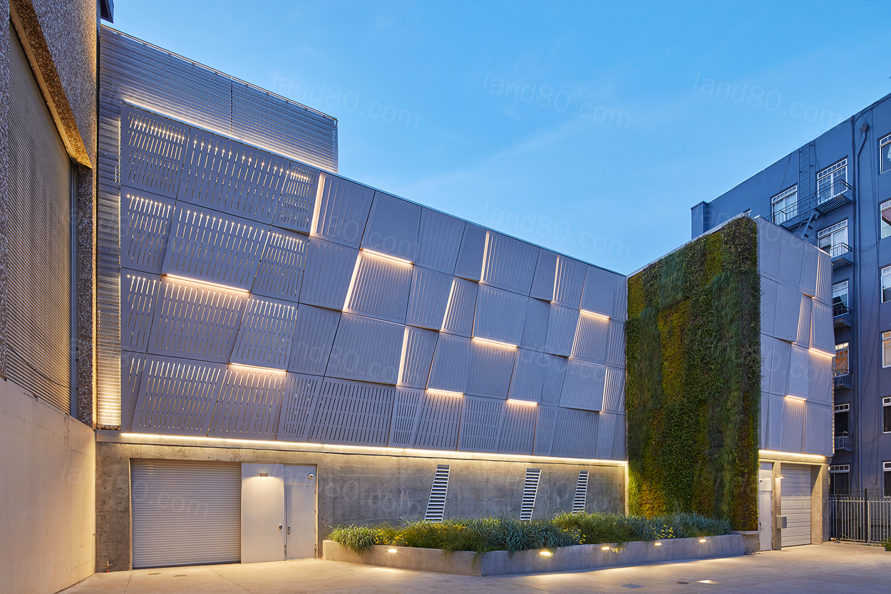新落成的电气开关设备大楼是美国第一座净零能耗(NZE)的变电站大楼。 这座钢框架混凝土结构位于Larkin和Hyde之间的Eddy街区,是对PG&E设计的历史悠久的1962年变电站建筑的当代完善,旨在为城市东北部供电。
The newly completed electrical switchgear
building is the first Net Zero Energy (NZE) targeted electrical substation
building in the United States. Tucked midblock on Eddy Street between Larkin
and Hyde, the steel frame concrete structure is a modern addition to the
existing historic 1962 substation building designed by PG&E to supply power
to the northeastern part of the city.



建筑有约束力的属性和需要容纳起重机和设备升降机通道限制了新建筑的扩展,使其需要与现有变电站的方向垂直。实用主义的结构立面面向街道,集成了三种类型的GFRP面板:倾斜、穿孔和螺纹,它们共同构成一个多面的建筑表面,掩盖了其原本简朴的材特性。 每块面板都经过单独制作,带有肋状筋,在阳光下投射线性阴影图案,随时间和季节的更替创造不断变化的表面。
The constrained property and need to
accommodate crane and equipment lift access prescribed the expansion’s
perpendicular orientation to the existing substation. The utilitarian structure
features street-facing façades that integrate three types of GFRP panels – sloped,
perforated, and ribbed – to form a faceted surface that belies its otherwise
modest materiality. Each panel is individually crafted and unique, with
ribs that cast linear shadow patterns in sunlight, creating an ever-changing
surface throughout the day and year.
▽随时间和季节的更替创造不断变化的表面


▽建筑表面细节


倾斜面板中嵌入照明装置,夜间可在建筑表面上产生动态效果,同时象征着城市的动态电网。西向的绿植墙以几何图案种植,与多面混凝土墙相互呼应,为城市街区提供了生机勃勃的自然氛围,同时为绿化率做出积极贡献。细密度的金属网在现有和新增设计之间提供了过渡,同时用于固定立面。
Sloped panels embedded with lighting
fixtures pulsate across the building at night, expressing the City’s dynamic
electrical power grid. The west-facing green wall, planted in a geometric
pattern that echoes the faceted concrete walls, provides biophilic relief to
the urban block while asserting its contribution to green values. A
fine-grained metal mesh provides a transition between the existing and new
addition and is also used to bookend the façade.
▽嵌入的照明装置




▽绿植墙

在建筑顶部,60千瓦的太阳能电池板阵列供给了建筑物的能耗。 建筑物底部的大型通风口通过自然通风利用城市的凉爽温度,从而减少人们对人工制冷的依赖,并将建筑物的能源负荷降低近40%。 室内的备用风扇仅在高温下触发,以便在需要时有助于冷却建筑物。团队通过全面深入的了解每台设备(从机械系统到洗手间的干手器)的电气需求,从而逐步降低了能耗。
On top, 60 kW solar panel arrays offset the
building’s energy consumption. Large vents at the base of the building
exploit the City’s cool temperatures through natural ventilation that help
eliminate the need for artificial cooling and reduce the building’s energy load
by nearly 40 percent. Inside, supplemental fans, triggered only at high temperatures,
help to cool the building only when needed. A comprehensive deep dive to
understand the electrical needs of each discreet piece of equipment – from
mechanical systems to the hand dryer in the restrooms – led to an incremental
load reduction.

PG&E
Larkin变电站是首个获得国际生活未来研究所(ILFI)的“生活建筑挑战赛”评级的目标净零电气开关设备公共建筑。设计团队与ILFI合作,共同建立了一个评级系统用于这种前所未有的建筑类型。
The PG&E Larkin Substation addition is
the first targeted net-zero electrical switchgear utility building to get a
rating from the International Living Future Institute’s (ILFI) Living Building
Challenge. The design team collaborated with ILFI in order to establish a
rating system for registering the unprecedented building type.
▽总平面图

▽平面图
▽轴测图

Project team
TEF Design (architecture)
Plant Construction Company, LP (general
contractor)
Creo Landscape (landscape architecture)
BFK Engineers (civil engineering)
Rutherford + Chekene (structural
engineering)
MHC Engineers, Inc. (MEP engineering)
Horton Lees Brogden Lighting Design
(lighting)
Urb-in (utility consultant/owner’s
representative)
Thornton Thomasetti (sustainability
consultant)
TEF Design team
Andrew Wolfram, AIA (Principal-In-Charge)
Paul Cooper, AIA (Project Manager)
Justin Blinn, AIA (Project Designer)
Photography
Mikiko Kikuyama
|